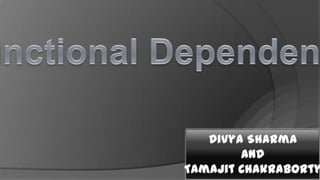
Functional dependency
- 2. Definition A functional dependency is defined as a constraint between two sets of attributes in a relation from a database. Given a relation R, a set of attributes X in R is said to functionally determine another attribute Y, also in R, (written X → Y) if and only if each X value is associated with at most one Y value.
- 3. In other words…. X is the determinant set and Y is the dependent attribute. Thus, given a tuple and the values of the attributes in X, one can determine the corresponding value of the Y attribute.
- 4. Example Employee SSN Name JobType DeptName 557-78-6587 Lance Smith Accountant Salary 214-45-2398 Lance Smith Engineer Product Note: Name is functionally dependent on SSN because an employee’s name can be uniquely determined from their SSN. Name does not determine SSN, because more than one employee can have the same name..
- 5. Keys Whereas a key is a set of attributes that uniquely identifies an entire tuple, a functional dependency allows us to express constraints that uniquely identify the values of certain attributes. However, a candidate key is always a determinant, but a determinant doesn’t need to be a key.
- 6. Closure Let a relation R have some functional dependencies F specified. The closure of F (usually written as F+) is the set of all functional dependencies that may be logically derived from F. Often F is the set of most obvious and important functional dependencies and F+, the closure, is the set of all the functional dependencies including F and those that can be deduced from F. The closure is important and may, for example, be needed in finding one or more candidate keys of the relation.
- 7. Example Student SNo SName CNo CName Addr Instr. Office 5425 Susan Ross 102 Calc I …San Jose, CA P. Smith B42 Room 112 7845 Dave Turco 541 Bio 10 ...San Diego, CA L. Talip B24 Room 210 SNo -> SName CNo -> CName Instr -> Office SNo -> Addr CNo -> Instr
- 8. Axioms Before we can determine the closure of the relation, Student, we need a set of rules. Developed by Armstrong in 1974, there are six rules (axioms) that all possible functional dependencies may be derived from them.
- 9. Axioms Cont. 1. Reflexivity Rule --- If X is a set of attributes and Y is a subset of X, then X Y holds. each subset of X is functionally dependent on X. 2. Augmentation Rule --- If X Y holds and W is a set of attributes, then WX WY holds. 3. Transitivity Rule --- If X Y and Y Z holds, then X Z holds.
- 10. Derived Theorems from Axioms 4. Union Rule --- If X Y and X Z holds, then X YZ holds. 5. Decomposition Rule --- If X YZ holds, then so do X Y and X Z. 6. Pseudotransitivity Rule --- If X Y and WY Z hold then so does WX Z.
- 11. Back to the Example SNo SName CNo CName Addr Instr. Office Based on the rules provided, the following dependencies can be derived. (SNo, CNo) SNo (Rule 1) -- subset (SNo, CNo) CNo (Rule 1) (SNo, CNo) (SName, CName) (Rule 2) -- augmentation CNo office (Rule 3) -- transitivity SNo (SName, address) (Union Rule) etc.
- 12. Too Many FDs Using the first rule alone, from our example we have 2^7 = 128 subsets. This will further lead to many more functional dependencies. This defeats the purpose of normalizing relations. So what now? One way is to deal with one attribute or a set of attributes at a time and find its closure (i.e. all functional dependencies relating to them). The aim of this exercise is to find what attributes depend on a given set of attributes and therefore ought to be together.
- 13. The approach Step 1 Let X^c <- X Step 2 Let the next dependency be A -> B. If A is in X^c and B is not, X^c <- X^c + B. Step 3 Continue step 2 until no new attributes can be added to X^c.
- 14. Back To Our Example Consider the following relation: student(SNo, SName, CNo, CName). We wish to determine the closure of (SNo, CNo). We have the following functional dependencies. SNo -> SName CNo -> CName Step 1 --- X^c <- X, that is, X^c <- (SNo, CNo) Step 2 --- Consider SNo -> SName, since SNo is in X^c and SName is not, we have: X^c <- (SNo, CNo) + SName Step 3 --- Consider CNo -> CName, since CNo is in X^c and CName is not, we have: X^c <- (SNo, CNo, SName) + CName Step 4 --- Again, consider SNo -> SName but this does not change X^c. Step 5 --- Again, consider CNo -> CName but this does not change X^c. Therefore X+ = X^c = (SNo, CNo, SName, CName). This shows that all the attributes in the relation student (SNo, CNo, SName, CName) are dependent on (SNo, CNo) and therefore (SNo, CNo) is a candidate key of the present relation. In this case, it is the only candidate key.
- 15. Normal Form Initially Codd (1972) presented three normal forms (1NF, 2NF and 3NF) all based on functional dependencies among the attributes of a relation. Later Boyce and Codd proposed another normal form called the Boyce-Codd normal form (BCNF). The fourth and fifth normal forms are based on multi-value and join dependencies and were proposed later. The primary objective of normalization is to avoid anomalies.
